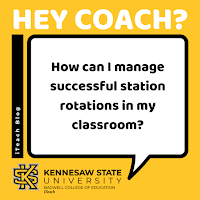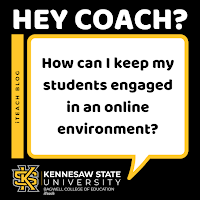Tips for Managing Successful Station Rotations
 Hey Coach,
Hey Coach, I love using stations, voice, and choice in my classroom, but I am having trouble managing behavior. Do you have any suggestions?
Sincerely,
Struggling with Stations
Kudos to you for giving your students voice and choice in how they learn! Managing behavior is a common issue teachers face when implementing stations, so know that you are not alone.
Keep in mind that all behavior is a form of communication, so it’s important to reflect on why students are exhibiting a specific action. Figuring out why the behavior is occurring will help you determine how to address it. We know that’s hard to do in the moment, but we can train ourselves to be better at this. Some common messages your students might communicate during your stations are:
- I’m confused about this task.
- This is too hard/easy for me.
- I’m having a hard time working with my partner/group.
- I’m frustrated.
- I don’t know how to use this tool.
Teaching executive function skills could be the answer. Executive function skills help us prioritize, plan, and focus so that we can complete multiple tasks successfully. Stations are a great way to build and practice these skills. If you notice that students are off-task at a station because the task is too difficult, perhaps you can create tiered versions of the task to ensure work is engaging and accessible to all students. After the tiered version is created, students can make a decision about which task they believe is the best fit for them. This may require some conferring with the student so they can recognize which tasks will be too easy or may challenge them. Self-regulation and self-advocacy are executive function skills that need to be developed, and these conferences will aid in this process. If you’d like more suggestions on how to support learners as they develop executive function skills, check out our Supporting Executive Function infographic.
It’s also important to model and practice the behaviors that will lead to productive station time. The white paper Evidence-based Kernels: Fundamental Units of Behavioral Influence examines existing evidence that shows units of behavioral influence, or kernels, can produce behavioral shifts. This simply means that making small changes, such as using verbal cues during transitions, can positively change behavior (Embry & Biglan, 2008). So how can we put these kernels into practice?
 |
| Tips for Successful Station Rotations |
For more information on classroom management and learning through stations, check out Todd Finey’s article 11 Research-Based Classroom Management Strategies or TeachThought’s article How to Scaffold Learning through Station Teaching. By identifying expectations and creating a plan for how you will help students meet these expectations, you can ensure that all students are engaged and productive during stations in your classroom.
Yours truly,
Coach
Contributing Coaches Sarah Yoo and Kristen Klinger



Comments
Post a Comment